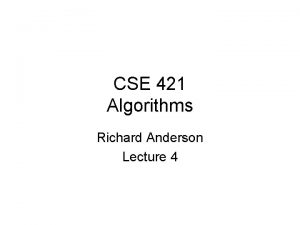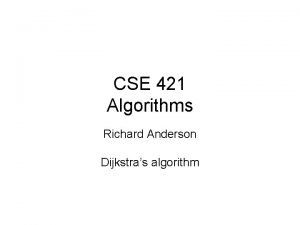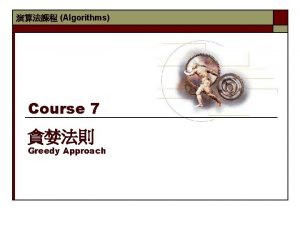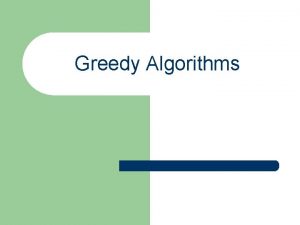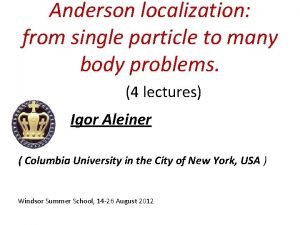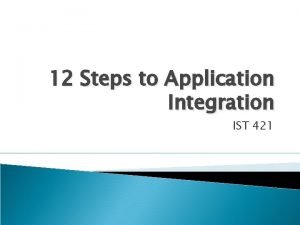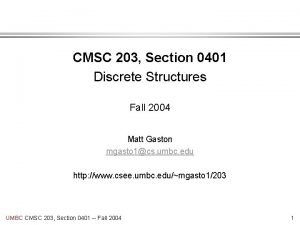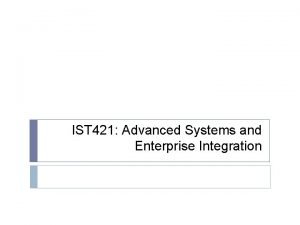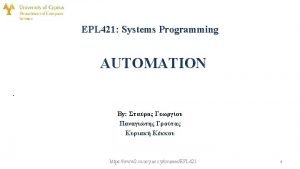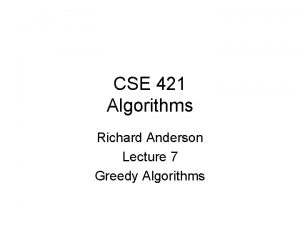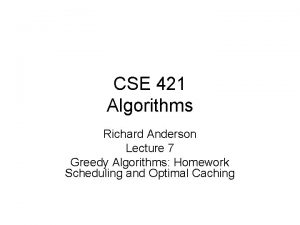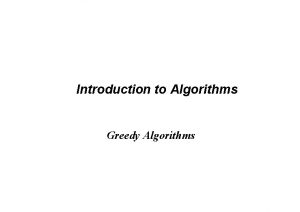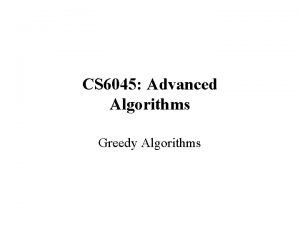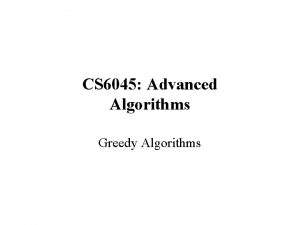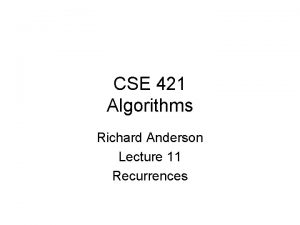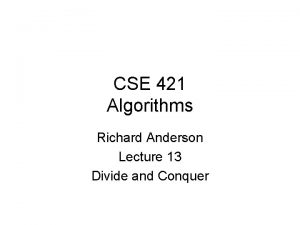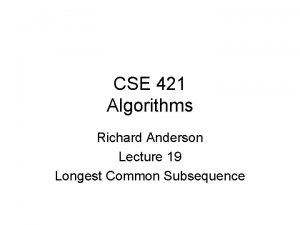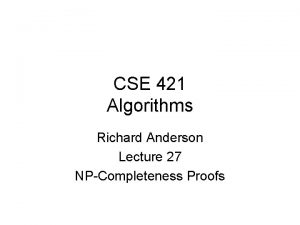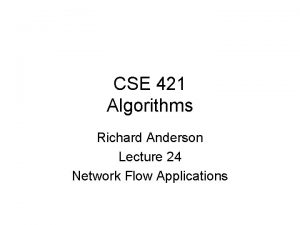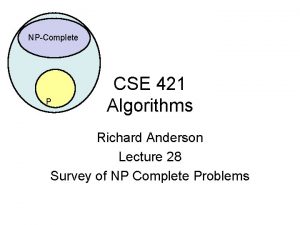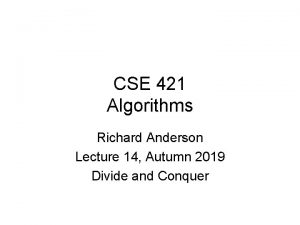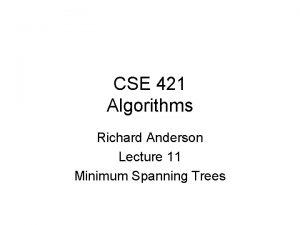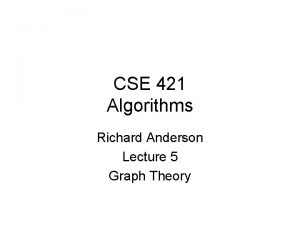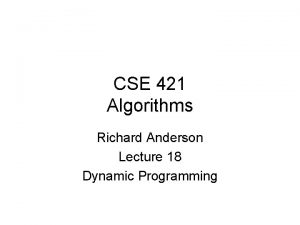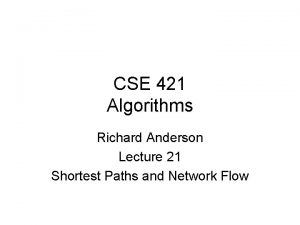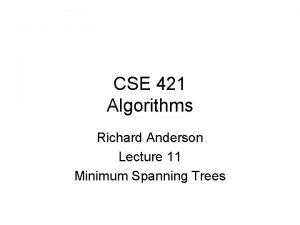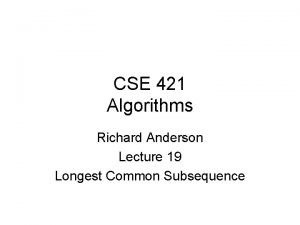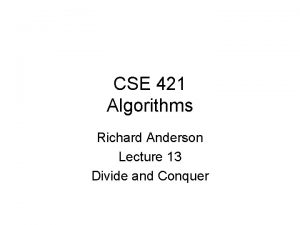CSE 421 Algorithms Richard Anderson Lecture 6 Greedy



































- Slides: 35

CSE 421 Algorithms Richard Anderson Lecture 6 Greedy Algorithms

Greedy Algorithms • Solve problems with the simplest possible algorithm • The hard part: showing that something simple actually works • Pseudo-definition – An algorithm is Greedy if it builds its solution by adding elements one at a time using a simple rule

Scheduling Theory • Tasks – Processing requirements, release times, deadlines • Processors • Precedence constraints • Objective function – Jobs scheduled, lateness, total execution time

Interval Scheduling • Tasks occur at fixed times • Single processor • Maximize number of tasks completed • Tasks {1, 2, . . . N} • Start and finish times, s(i), f(i)

What is the largest solution?

Greedy Algorithm for Scheduling Let T be the set of tasks, construct a set of independent tasks I, A is the rule determining the greedy algorithm I={} While (T is not empty) Select a task t from T by a rule A Add t to I Remove t and all tasks incompatible with t from T

Simulate the greedy algorithm for each of these heuristics Schedule earliest starting task Schedule shortest available task Schedule task with fewest conflicting tasks

Greedy solution based on earliest finishing time Example 1 Example 2 Example 3

Theorem: Earliest Finish Algorithm is Optimal • Key idea: Earliest Finish Algorithm stays ahead • Let A = {i 1, . . . , ik} be the set of tasks found by EFA in increasing order of finish times • Let B = {j 1, . . . , jm} be the set of tasks found by a different algorithm in increasing order of finish times • Show that for r<= min(k, m), f(ir) <= f(jr)

Stay ahead lemma • A always stays ahead of B, f(ir) <= f(jr) • Induction argument – f(i 1) <= f(j 1) – If f(ir-1) <= f(jr-1) then f(ir) <= f(jr)

Completing the proof • Let A = {i 1, . . . , ik} be the set of tasks found by EFA in increasing order of finish times • Let O = {j 1, . . . , jm} be the set of tasks found by an optimal algorithm in increasing order of finish times • If k < m, then the Earliest Finish Algorithm stopped before it ran out of tasks

Scheduling all intervals • Minimize number of processors to schedule all intervals

How many processors are needed for this example?

Prove that you cannot schedule this set of intervals with two processors

Depth: maximum number of intervals active

Algorithm • Sort by start times • Suppose maximum depth is d, create d slots • Schedule items in increasing order, assign each item to an open slot • Correctness proof: When we reach an item, we always have an open slot

Homework Scheduling • Tasks to perform • Deadlines on the tasks • Freedom to schedule tasks in any order

Scheduling tasks • • Each task has a length ti and a deadline di All tasks are available at the start One task may be worked on at a time All tasks must be completed • Goal: minimize maximum lateness – Lateness = fi – di if fi >= di

Example Time Deadline 2 2 4 3 2 Lateness 1 3 3 2 Lateness 3

Determine the minimum lateness Time Deadline 6 2 4 3 4 5 5 12

Greedy Algorithm • Earliest deadline first • Order jobs by deadline • This algorithm is optimal

Analysis • Suppose the jobs are ordered by deadlines, d 1 <= d 2 <=. . . <= dn • A schedule has an inversion if job j is scheduled before i where j > i • The schedule A computed by the greedy algorithm has no inversions. • Let O be the optimal schedule, we want to show that A has the same maximum lateness as O

List the inversions Time a 1 3 a 2 a 3 a 4 Deadline 4 4 5 2 6 12 5 a 4 a 2 a 1 a 3

Lemma: There is an optimal schedule with no idle time a 4 a 2 a 3 a 1 • It doesn’t hurt to start your homework early! • Note on proof techniques – This type of can be important for keeping proofs clean – It allows us to make a simplifying assumption for the remainder of the proof

Lemma • If there is an inversion i, j, there is a pair of adjacent jobs i’, j’ which form an inversion

Interchange argument • Suppose there is a pair of jobs i and j, with di <= dj, and j scheduled immediately before i. Interchanging i and j does not increase the maximum lateness. j di d j i i di d j j

Proof by Bubble Sort d 1 a 1 d 2 d 3 d 4 a 2 a 1 a 2 Determine maximum lateness a 3 a 1 a 3 a 4

Real Proof • There is an optimal schedule with no inversions and no idle time. • Let O be an optimal schedule k inversions, we construct a new optimal schedule with k-1 inversions • Repeat until we have an optimal schedule with 0 inversions • This is the solution found by the earliest deadline first algorithm

Result • Earliest Deadline First algorithm constructs a schedule that minimizes the maximum lateness

Extensions • What if the objective is to minimize the sum of the lateness? – EDF does not seem to work • If the tasks have release times and deadlines, and are non-preemptable, the problem is NP-complete • What about the case with release times and deadlines where tasks are preemptable?

Optimal Caching • Caching problem: – Maintain collection of items in local memory – Minimize number of items fetched

Caching example A, B, C, D, A, E, B, A, D, A, C, B, D, A

Optimal Caching • If you know the sequence of requests, what is the optimal replacement pattern? • Note – it is rare to know what the requests are in advance – but we still might want to do this: – Some specific applications, the sequence is known – Competitive analysis, compare performance on an online algorithm with an optimal offline algorithm

Farthest in the future algorithm • Discard element used farthest in the future A, B, C, A, C, D, C, B, C, A, D

Correctness Proof • Sketch • Start with Optimal Solution O • Convert to Farthest in the Future Solution F-F • Look at the first place where they differ • Convert O to evict F-F element – There are some technicalities here to ensure the caches have the same configuration. . .
 Uw cse 421
Uw cse 421 Cse 421
Cse 421 Cse 421
Cse 421 N/a greedy
N/a greedy Huffman coding - greedy algorithm
Huffman coding - greedy algorithm Greedy algorithm
Greedy algorithm Disadvantages of greedy algorithm
Disadvantages of greedy algorithm Anderson localization lecture notes
Anderson localization lecture notes Analysis of algorithms lecture notes
Analysis of algorithms lecture notes Introduction to algorithms lecture notes
Introduction to algorithms lecture notes Richard dean anderson hockey
Richard dean anderson hockey Richard anderson york university
Richard anderson york university 01:640:244 lecture notes - lecture 15: plat, idah, farad
01:640:244 lecture notes - lecture 15: plat, idah, farad Looking for richard
Looking for richard 4 2 1 rule
4 2 1 rule Ist 421
Ist 421 Ist 421
Ist 421 Me 421
Me 421 Fwm 421
Fwm 421 421 rule
421 rule Aae 421
Aae 421 Psy
Psy Comp421
Comp421 Cmsc 203 umbc
Cmsc 203 umbc Biba n 421 ddl
Biba n 421 ddl Estimated blood loss formula
Estimated blood loss formula Epl 421
Epl 421 Bell delaware method
Bell delaware method Processist
Processist Ist 421
Ist 421 Cs 421 uiuc
Cs 421 uiuc Cmsc 421
Cmsc 421 Cmsc421
Cmsc421 Ist 421
Ist 421 4-2-1 rule
4-2-1 rule Cs 421 github
Cs 421 github
